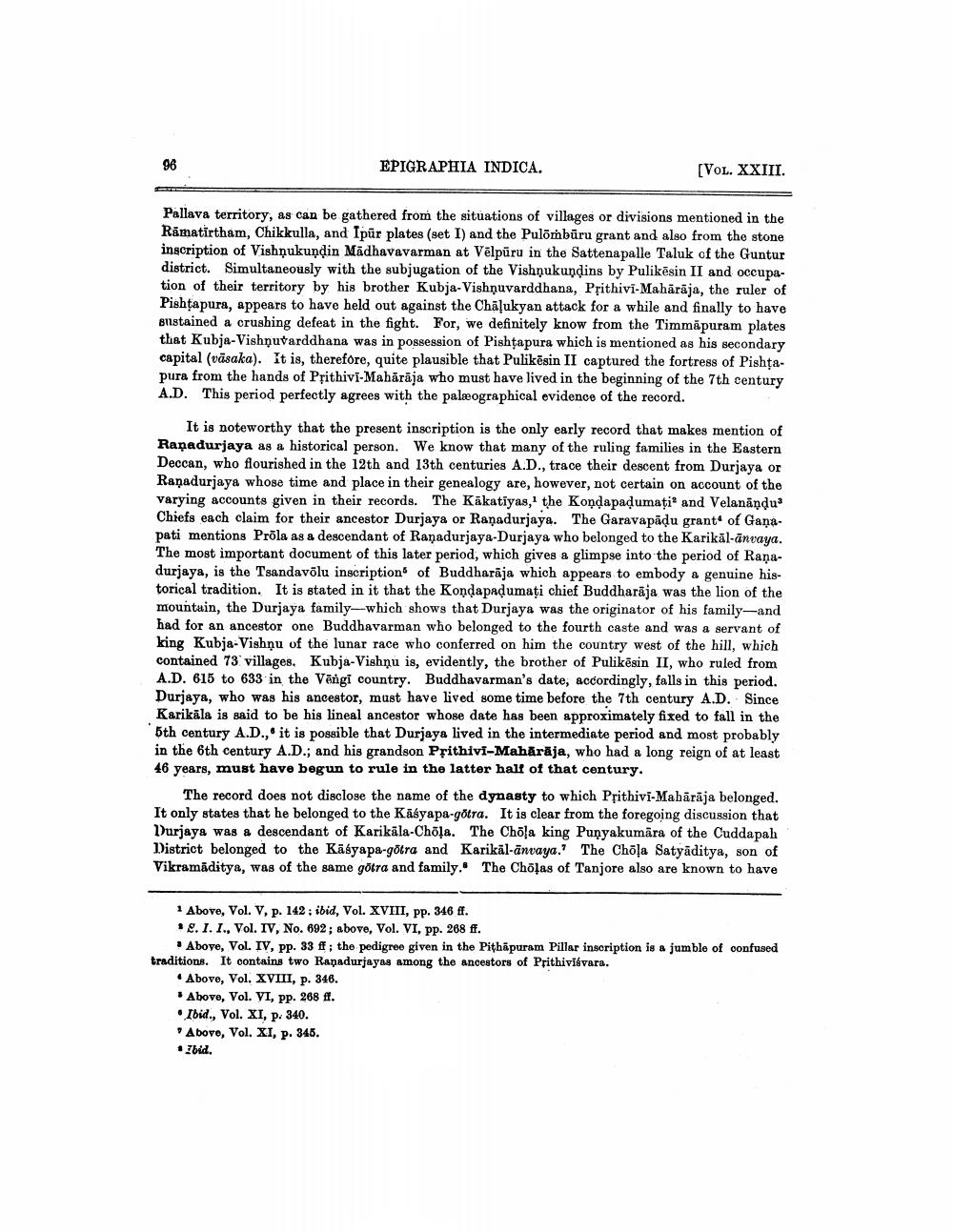________________
EPIGRAPHIA INDICA.
(VOL. XXIII.
Pallava territory, as can be gathered from the situations of villages or divisions mentioned in the Rāmatirtham, Chikkulla, and Ipār plates (set I) and the Pulombūru grant and also from the stone inscription of Vishnukundin Madhavavarman at Vēlpūru in the Sattenapalle Taluk of the Guntur district. Simultaneously with the subjugation of the Vishnukundins by Pulikēsin II and occupation of their territory by his brother Kubja-Vishộuvarddhana, Pșithivi-Mahārāja, the ruler of Pishtapura, appears to have held out against the Chāļukyan attack for a while and finally to have sustained a crushing defeat in the fight. For, we definitely know from the Timmāpuram plates that Kubja-Vishnuvarddhana was in possession of Pishtapura which is mentioned as his secondary capital (vāsaka). It is, therefore, quite plausible that Pulikēsin II captured the fortress of Pishtapura from the hands of Prithivi-Mahārāja who must have lived in the beginning of the 7th century A.D. This period perfectly agrees with the palæographical evidence of the record.
It is noteworthy that the present inscription is the only early record that makes mention of Rapadurjaya as a historical person. We know that many of the ruling families in the Eastern Deccan, who flourished in the 12th and 13th centuries A.D., trace their descent from Durjaya or Raņadurjaya whose time and place in their genealogy are, however, not certain on account of the varying accounts given in their records. The Kakatiyas, the Kondapadumati* and Velanānu Chiefs each claim for their ancestor Durjaya or Ranadurjaya. The Garavapādu grant of Gaņapati mentions Prola as a descendant of Raņadurjaya-Durjaya who belonged to the Karikāl-anvaya. The most important document of this later period, which gives a glimpse into the period of Ranadurjaya, is the Tsandavõlu inscription of Buddharāja which appears to embody a genuine historical tradition. It is stated in it that the Kondapadumaţi chief Buddharaja was the lion of the mountain, the Durjaya family--which shows that Durjaya was the originator of his family-and had for an ancestor one Buddhavarman who belonged to the fourth caste and was a servant of king Kubja-Vishnu of the lunar race who conferred on him the country west of the hill, which contained 73 villages. Kubja-Vishnu is, evidently, the brother of Pulikēsin II, who ruled from A.D. 615 to 633 in the Vēngi country. Buddhavarman's date, accordingly, falls in this period. Durjaya, who was his ancestor, must have lived some time before the 7th century A.D. Since Karikāla is said to be his lineal ancestor whose date has been approximately fixed to fall in the 5th century A.D.,. it is possible that Durjaya lived in the intermediate period and most probably in the 6th century A.D.; and his grandson Přithivi-Mahārāja, who had a long reign of at least 46 years, must have begun to rule in the latter half of that century.
The record does not disclose the name of the dynasty to which Prithivi-Mahārāja belonged. It only states that he belonged to the Kāśyapa-gotra. It is clear from the foregoing discussion that Durjaya was a descendant of Karikāla-Choļa. The Chola king Punyakumāra of the Cuddapah District belonged to the Kāsyapa-gotra and Karikāl-ānvaya.? The Chōļa Satyāditya, son of Vikramaditya, was of the same götra and family. The Chöļas of Tanjore also are known to have
1 Above, Vol. V, p. 142; ibid, Vol. XVIII, pp. 346 ff. • £. I. I., Vol. IV, No. 692; above, Vol. VI, pp. 288 ff.
. Above, Vol. IV, pp. 33 ff; the pedigree given in the Pithapuram Pillar inscription is a jumble of confused traditions. It contains two Rapadurjayas among the ancestors of Prithivisvara.
• Above, Vol. XVIII, p. 346. Above, Vol. VI, pp. 268 ff. Ibid., Vol. XI, p. 340. Above, Vol. XI, p. 346. • Zbid.




